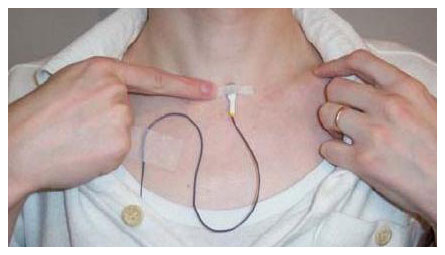Occupational Health: Caring for the Teaching Voice
These investigations address an important public need: the protection of an estimated 10 million workers in the U.S. who rely heavily on their voices as the primary tool of trade. Evidence has been growing that occupational voice users -- such as teachers, telephone workers, ministers, counselors and interviewers -- are at risk for vocal injury because they get inadequate recovery times from prolonged speaking.
The underlying hypothesis is that there is a limited vibration dose that vocal fold tissues can withstand. Just like the hand-transmitted vibration from power tools (such as a jackhammer), a safe dose of vocal vibration is governed by frequency, amplitude, and duration of vibration exposure. Microphone use solves the overdose problem related to vocal loudness, but does not address the problem of excessive duration.
 A voice dosimeter has been designed, tested, and is currently in use by teachers in the Denver area public school system to measure vocal dose. (See photo at left.) The teachers also self-monitor their vocal fatigue levels in journals. Early studies tracked the vibrations of teachers' vocal folds, in an attempt to quantify the load on vocal tissues. These numbers were compared to the teachers' impressions of their vocal symptoms.
A voice dosimeter has been designed, tested, and is currently in use by teachers in the Denver area public school system to measure vocal dose. (See photo at left.) The teachers also self-monitor their vocal fatigue levels in journals. Early studies tracked the vibrations of teachers' vocal folds, in an attempt to quantify the load on vocal tissues. These numbers were compared to the teachers' impressions of their vocal symptoms.
Now that this work is complete, research has turned toward the molecular underpinnings of tissue response to excessive vibration. Specific aims are to:
- determine the ideal geometric and viscoelastic properties of the lamina propria,
- quantify voice recovery times and relate them to auto-perceptive ratings,
- culture distinct cell types at various states of differentiation,
- determine the relative merits of co-culture for in vitro monolayer systems,
- engineer a 3-dimensional in vitro model of the lamina propria in a bioreactor,
- identify and functionally characterize candidate vibration-responsive genes,
- develop a theoretical model of economic voice production, and
- explore two types of economy-based vocal therapy.
The ultimate goal is to provide heavy voice users with safety criteria based on genetic disposition to vocal injury, degree of training in economic voice use, accumulated dose of vibration in a typical work day, and the amount of recovery available at night and on weekends. A multi-disciplinary research team has been assembled to address this public health concern at physical, biochemical, molecular, and behavioral levels of investigation.
Final Summary
![]() This research was funded primarily from a National Institutes of Health contract. That contract has come to conclusion with a final progress report here [link to attached]. While this contract has concluded, we are continuing our research in occupational voice use.
This research was funded primarily from a National Institutes of Health contract. That contract has come to conclusion with a final progress report here [link to attached]. While this contract has concluded, we are continuing our research in occupational voice use.


